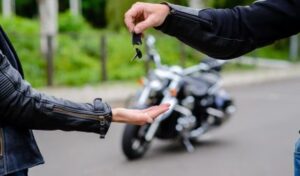Scratches on a car, bike, or scooter are a common issue. Sometimes the scar is your fault, and sometimes it’s someone else’s.
The appearance of abrasions also diminishes the vehicle’s aesthetic appeal. In such a circumstance, it is essential that you are familiar with removal techniques.
Here, I will discuss scratch removal techniques that can be performed at home.
In addition, the cost depends on the size of the scratch.
I even put those suggestions into practice, and they were extremely helpful.
To remove or fix the scratches, all you need are a few tools or other things that will be helpful. Let’s begin with this article and see where it takes us in terms of the results.
Follow 3 Tips To Fix Bike Scratches
I’m going to share with you some common and simple tweaks that can make your bike look brand new.
These will only require a short amount of time on your part, and you will need only a few things.
1. Using Toothpaste for Surface Scratches:
You will need toothpaste, soap, a hose, a sponge, and microfiber towels in order to remove surface scratches from a bike.
Now, proceed by following the instructions in the list below, step by step.
Run your fingernail over the scratch to see if it’s deep or light.
If your fingernail doesn’t grab onto the scratch, it’s just above the surface, and toothpaste may be a good idea. If your fingernail can grab it, it’s deep and you should seek professional scratch removal products.
Wash and dry the scratched area
Before applying toothpaste to the scratch, make sure the area is completely clean. Scratches can be made worse by applying dirt and grime to the area.
You can take the motorcycle to a motorcycle wash or wash it yourself.
To wash your motorcycle yourself, get it completely wet by spraying it with a hose, then remove most of the dirt and dust.
Then, use a large sponge or motorcycle washing brush to apply soap made for bike and cars.
Apply the soap thoroughly to the surface of the motorcycle, then rinse it off with a hose. Dry the motorcycle with a clean, dry towel.
Apply a quarter-sized amount of toothpaste to a damp microfiber towel.
Soak your microfiber towel until it is thoroughly damp. Then apply a quarter-sized amount of toothpaste to the towel, but you can use more depending on the size of the scratch.
While whitening toothpastes are best, you can remove these scratches with any available toothpaste.
You should apply this toothpaste with a soft, clean microfiber towel so that the toothpaste doesn’t rub off and cause further damage.
Rub the toothpaste onto the scratch in a circular motion.
Using gentle pressure on the microfiber cloth, move it in a circular motion to cover all of the scratches.
Do this until all the toothpaste is evenly spread over the surface. You will have to apply some pressure while applying the toothpaste, but make sure not to apply too much force.
Wash off excess toothpaste
Once you’ve applied toothpaste to all scratches, wash off any excess toothpaste that may have gotten into it.
Pour water over your car with the help of a hose and then dry the area with a micro fiber towel.
You can even remove excess toothpaste with a damp micro fiber towel.
Repeat this process two more times
You may have to use the toothpaste more than once to remove the scratch from the surface.
Check the area to see if the scratches are still visible, and if so, repeat the process one or two more times as needed.
Keep in mind that you do not use more than 3 times because doing so can damage the paint of the car.
2. Remove Minor Scratches With A Scratch Removal Product:
If you want to get rid of some minor scratches on your motorcycle, you can do so with a few different things, like soap, a hose, a sponge, some microfiber towels (for drying the motorcycle), a scratch removal kit, a buffing pad or microfiber towel, and other similar items.
Then, take a look at how effectively it removes stains from your bike.
Wash your car so that there is no dust or dirt in the scratch.
It is important to make sure that the area is completely clean before applying any product. If there is any dirt or dust on the surface, it can create more scratches.
Get the car completely wet by spraying it with a hose before applying the soap.
Then, work the soap into it using a sponge made for cars or a car washing brush.
Rinse off the soap thoroughly, and then dry the car with a microfiber towel. Keep in mind that the soap is made only for washing the car.
Purchase a scratch removal product or kit.
You can buy scratch removal products at any auto supply store or in the auto supply section of a larger store.
These products are sold as scratch removal product kits and often include scratch removal solution or buffing pads for applying other products.
If you’re not sure which type of scratch removal product to buy, ask a sales associate for help. People who work at auto supply stores are often familiar with such products.
Microfiber towels are often best for applying these scratch removal products because they are gentler on the surface of your car.
Some products come with a mechanical buffing tool to make it easier to remove scratches.
Apply a quarter-size amount of scratch removal product to the pad.
You may need a little more or less product depending on the size of the scratched area.
Apply the product to a buffing pad or microfiber cloth, and then fold it in half to spread the product completely over the surface of the pad or cloth.
Make sure that the product is completely spread over the surface of the cloth or pad before you begin.
Apply the product to the scratched area and surrounding areas.
You can apply the product in a circular motion or back and forth. Do what you are most comfortable with and take care of the space; under no circumstances change direction!
Go in circles or back and forth. Work the product for a few minutes to allow it to spread.
Make sure to apply light to moderate pressure while applying the product.
Wipe off any remaining product.
Once you’ve buffed the scratched area, take a clean microfiber cloth and wipe away the excess product. Buff the surface of the car thoroughly, moving in a circular motion.
Under no circumstances allow excess product to dry on the surface of your car.
Check the manufacturer’s instructions for how to remove excess product.
3. Paint To Repair Deeper Scratches:
After reviewing the previous two steps for normal or minor scratches, let’s move on to the deeper ones.
You will also need soap, a hose, a sponge, microfiber towels (for drying the motorcycle), 1500- and 2000-grit sandpaper, a sanding pad, a sander, sandable spray primer, spray paint that matches the color of your motorcycle, and motorcycle wax.
Now, begin painting by following the steps listed below.
Wash and dry your car thoroughly
If your car is dirty when you fix a scratch, that grime can cause more scratches. Wash your car in such a way that all the dirt and dust is removed.
You will need to wash the scratched area several times to make sure it is clean. Pay close attention to the area where you want to remove the scratch.
Spray the scratched area with water, and try to get all the dirt out of the area around the scratch.
Then, apply soap that’s made for use only on cars to the area and wash it off with clean water.
Remove the top layer of paint by sanding the scratched area.
Wrap 2000-grit wet/dry sandpaper around the sanding pad (the sandpaper holder that includes the handle) and sand the area. Start sanding.
Sand for 10 to 15 seconds, then look at the part to see if it needs more sanding. Always sand in the direction of the scratch.
You don’t want to create more scratches, as these can create more bumps and dips in the paint.
Wash the area with water to see your progress.
This will give you an accurate idea of whether you have reached inside the scratch or not.
If your scratch is a little deeper than the coat of paint, smooth the surface with 1500-grit sandpaper, and then use 2000-grit sandpaper to buff away the rough sandpaper scratch.
Try not to get any dirt or dust between the sandpaper and the car. This can make scratches worse.
Wash and dry the area
Wash off any dirt that may have formed after sanding the scratched area. Then, wipe and dry the area thoroughly with a clean microfiber cloth. Do not use dirty or old cloths, otherwise it will scratch the surface of the car more.
Spray a few coats of primer over the sanded area.
Dispense a small amount of coil primer in an aerosol can. Spray primer on the area you just sanded.
Spray the paint by moving your hand back and forth. Then, wait 5 to 10 minutes for the primer to dry, and then spray on another layer.
If possible, choose a primer that matches your car’s paint color. It won’t match exactly, but your paint will match it.
Apply a few coats of paint that match your car’s color.
Next, apply your car’s paint to the primed area. Wait 5 to 10 minutes after each application to allow the paint to dry.
To be sure that the paint will match, get the same shade of paint from the manufacturer of your car.
You can find this paint at any auto supply store or order it specifically from the car’s manufacturer.
Wax the area to seal the paint you just applied.
Apply a quality Carnauba Wax to the surface of your car and then buff the area with a buffer pad or microfiber cloth.
You can buy a waxing kit that will have everything you need to wax a car, such as wax and buffing pads or a microfiber cloth.
Apply a quarter-size amount of wax to a buffing pad or cloth to start, and build up the amount later. Use a pad or cloth with moderate pressure in a circular motion.
Keep doing this until the wax is evenly applied and the surface of the car starts shining.
Remove The Scratches On The Bike Headlights With Easy Hacks:
It is usual for the headlights of a car or bike to have scuff marks or scratches on them.
When the headlights get scratched, the lights often start falling in random directions instead of straight down to the ground.
Even after switching on the electric lights at night, there is frequently nothing but pitch blackness visible in front of the building.
If this describes your situation, and if your bike’s headlights also have an excessive number of scratches, then you absolutely need to read the advice that follows.
1. Use Wax:
It is true that wax is probably the best way to remove most scratches from the headlights of a car or motorcycle.
In order to accomplish this, begin by thoroughly mashing the beeswax. After that, spread the melted wax over the headlights and rub it in with some cotton.
After rubbing the wax well for about two or three minutes, you should wipe it well with a clean cloth.
2. Use Lens Cleaner:
The easiest and fastest way to get rid of scratches on the headlights of a car or motorcycle is to use lens cleaner.
In the event that you do not have any lens cleaner on hand, you can always purchase some from a local store.
Lens cleaner should be rubbed into the headlights.
Carry on in this manner for approximately two to three minutes. Scratches are simple to remove with this method.
3. Use Eraser:
Most of the time, the best way to quickly get rid of scratch marks on the headlights of a car or motorcycle is to use an eraser.
To accomplish this, rub the mark for approximately three to four minutes.
As a consequence of this, the headlights are significantly better than they were in the past.
It is recommended that you use a gentle eraser for this task rather than a rough one.
4. You Can Also Use These Things:
There are a number of other things that can be used in addition to wax, lens cleaner, and an eraser for the purpose of easily removing scratch marks from headlights.
To achieve this, you can make use of items such as toothpaste, liquid scratch remover, liquid car wax, and so on.
Conclusion
Another option for repairing scratches in painted surfaces is rubbing compound.
If the scuff marks in the paint of your motorcycle are significant or widespread, you might need to take it to a body shop in order to have them serviced.
Auto body shops have professional equipment and setups, and their staff is trained to make the bike’s surface look stunning and glossy.
In case you still have questions, please share them with us through the comment section.






